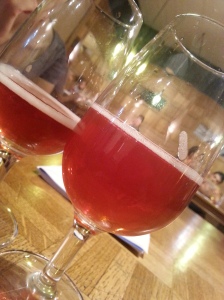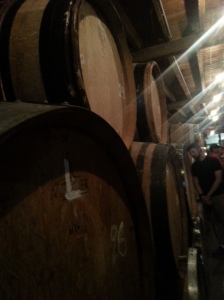
We are fortunate to now be able to drink a wide variety of fantastic beer from great UK breweries on a regular basis. With each great beer, I think a little higher of that brewery or the place it’s from, and the people who make it. But really, when I do that, I’m inside the bubble, thinking everything is rosy. I’m not complaining; I like it in the bubble. It’s a great bubble. Still, it’s only when someone from outside that bubble shares your appreciation that you can feel justified in your opinion. We like to say how great everything is (me included, I mean seriously, I’m doing it all the time) but it’s hard to know we are right without external corroboration. Worse still, it appears to some people that it’s the same breweries getting the attention all the time. So how do we measure fairly what’s really going on, and how far it has come? Let’s try.
Two legendary (and I don’t use that word lightly) American breweries made efforts to visit the UK late last year: Firestone Walker and Dogfish Head. FW, specifically David Walker and a handful of his brewing team, held a tap takeover at Craft Beer Co Covent Garden, whilst Sam Calagione, Dogfish Head’s founder, held a joint beer and food paired dinner with Beavertown and Charles Wells. These were highly desirable events that got people talking. Even though here in the UK we have begun to replicate the success and growth of self-identified craft beer that happened in the US in the 90s, it still feels special and exciting to have the chance to see, hear and speak to these important figures in brewing from across the pond.
Of course, David Walker is British himself, but even he must have been surprised to see how far the beer scene here has come in the past few years. Stood at the heaving bar of Craft Beer Co, California-tanned but armoured in the British institution of a Barbour coat against his homeland’s winter chill, the forty-odd taps of every style under the sun must have seemed both familiar to him, and alien. Cask and keg together in such numbers is almost unheard of even in the States. Imagine being in his position, returning home and being able to proudly put pints of The Kernel pale ale into his colleagues’ hands. He spoke later of just how great it was to see such a big step forward.
On the far side of London a few days later, Sam Calagione was expressing a feeling of bewilderment. In the interim between his beers no longer being available in the UK and now returning (a period of roughly four years) the founder of Dogfish Head discovered a fully-formed, hungry and ambitious UK craft beer scene, quite a different animal to the one he left behind (for example, Magic Rock didn’t even exist and BrewDog had only just opened a bar or two). On that day in late October last year, Calagione collaborated with brewers from Beavertown and distillers at East London Liquor Company to make a gin botanical-infused ‘Londonerweisse’ in the style of the light-and-sour Berliner Weisses of Germany. Then, in the evening, a dinner was held with beers from Beavertown, Dogfish Head and their DNA brewing partner Charles Wells, matched to dishes cooked and served at Duke’s in East London.

Beers like Midas Touch and 120 Minute IPA are pioneering classics, but here Calagione found beers like Gamma Ray nailing American pale ale as a style, whilst the likes of Wild Beer Co and Burning Sky are (finally) showing just how great the UK is at absorbing and co-opting influences from abroad and at home. He admitted he was quite taken aback by it all. It’s important that these kind of events continue to happen (and it’s also worth noting that the dinner wasn’t an isolated incident either – more recently, during London Beer Week, Beavertown pulled of a similar event with Camden Town Brewery and another visiting US brewer: Left Hand from Colorado).
The tickets for these extravagant epicurean feasts naturally come with a price tag, but one that, when considering the sheer amount of food and drink covered, are incredibly good value. The fact that Charles Wells had beers represented (an improved recipe DNA IPA and Courage Imperial Stout) showed this wasn’t craft beer elitism or just ‘the usual suspects’. And of course, while there is no direct comparison to be made, one can’t help but think a similar event held by several wine houses would have a ticket cost in the upper stratosphere. Still, it’s worth emphasising that it’s hard to compare such things directly, but also, more importantly, that the cost of the event doesn’t necessarily mean that the scene is becoming a elitist – if anything, it means that there are now events of every type to match every budget.
Those events last year are two examples, but don’t entirely serve as a perfect triangulation of measuring how far things have come, since both are from America. Who else then could provide assurance – somewhere traditional perhaps? How about a brewery that’s as traditional as it gets, not one that’s old-fashioned exactly, but one with a long heritage that has stuck to what is does best whilst keeping technologically updated with the times. How about the growth of Italian craft beer here, and that many of their brewmasters trained at traditional brewers in the UK? Too new? How about someone like Pilsner Urquell shipping tanks of unpasteurised brewery-fresh lager over in a matter of days to satisfy the breadth and growing appreciation of our palates for quality lager? Nah, starting at 1842 they are still mere children among brewers. Older, then? How about the oldest continuously operating brewery on the planet? Old enough for you?
Bayerische Staatsbrauerei Weihenstephan is home of one of the world’s leading brewing universities (well, one of the world’s leading universities full stop, really) and a brewery that has been operating since 1050. Its expressions of hefeweizen and Bavarian-style pilsner are timeless, world-beating classics. Perhaps this passed you by, but last year brewers from Weihenstephan did a collaboration with BrewDog. The resulting India Pale Weizen is being brewed again this year. Whilst a hopfenweisse is by no means a new thing, the meaning behind such a collaboration is frankly colossal.
I’ve written before that the rise of BrewDog has been as definitive point on our beer landscape – somewhere where we can point to and, with surety, know that things a different forever now. But the world’s oldest operating brewery, and let’s not beat about the bush here, Germans who don’t ever fuck about with their beer styles, decide to brew a collaboration with BrewDog, those guys with the tanks and the sharks and the hop cannons? I think it’s safe to say that based on those three examples we can say with certainty that our beer scene has entered, or is at least phasing into, a new stage.

But wait, you say. pretty much all of the UK brewers mentioned so far are probably in that ‘all the attention’ bracket. What about brewery X, Y, and indeed Z, which have been making amazing beers for yonks and don’t get any credit for it? What about them Chris, you trendy wazzock? Firstly, if you want a brewery that makes great beer to have more exposure, do something about it. Secondly, I am absolutely thrilled to bits to be in a position where we are this spoiled for choice. I am utterly ecstatic that there is so much to celebrate that we can’t decide how to cover it all. But what makes me happiest is that, because of that idea that some are getting more attention than others, we have entered a situation where good beer is being ‘normalised’. There is so much good beer near to us all right now that whether it is all getting the proper credit has become a feasible topic of discussion.
So where do we go from here? Is it really possible for the beer scene to keep growing? Undoubtedly. The appetite or rather the thirst for what is happening right now remains strong; unquenchable. The question is how to rationalise and balance the desire for the weird with the desire to normalise good beer to as many people as possible as a whole. I think the answer is that we don’t try to reconcile those two divergent trends and that, if anything, we should encourage them, because the divergence is resulting in diversity. Only by normalising good beer at one end, whilst still continuing to push boundaries of what beer can be at the other end, can the beer scene truly continue to evolve. If that means that, right now, it’s a group of brewers in each of those camps getting most of the attention, then so be it. It doesn’t diminish everyone else’s accomplishments, it merely highlights who is succeeding in being more inclusive and innovative on a regular basis.
It’s ultimately about growing (not like a brand with an advertising campaign, but like a living thing) what beer can mean to people. Do you ever wonder why it’s the same handful of images of beer used to illustrate any newspaper article about alcoholism, pub closures, alcohol consumption, breweries opening, beer duty rising or falling? That same bloody bloke with a filthy pint pot of brown-coloured ale in extreme-close up? It’s because, to the editors of those publications, it’s “just beer” and they’ll use whatever images they have for free. There’s no point spending money on costly new images when that one of a claggy nitro ale being sucked from a dirty glass will do.
Well, it won’t ‘do’ anymore, frankly. The distance between those images, and what beer is now and what it can be. has never been greater. The problem is that the use of those images is representative of popular opinion. Unfortunately, beer is “just beer” to many people and, as we have so recently been told, nothing to be “fussed over”. We have to champion and encourage this even widening range of things that beer can be, each as important as the one before or after, cask or keg or bottle or can or high-end or low-end, so that those images and the way beer is represented has to change to keep up.
We have to keep setting the pace and daring everyone else to recognise just how vast the growing breadth of traditional, esoteric, historic and cutting-edge beer is. Despite the odd clanger of a dated or misused photograph or naff article, I think we’re getting there. We just have to keep fighting the good fight, and show beer to be something that really can please all of the people, all of the time.








